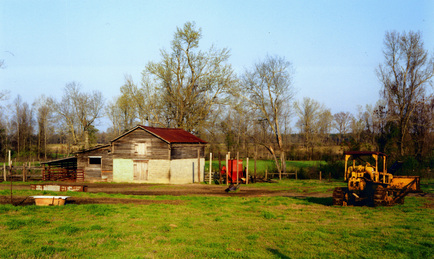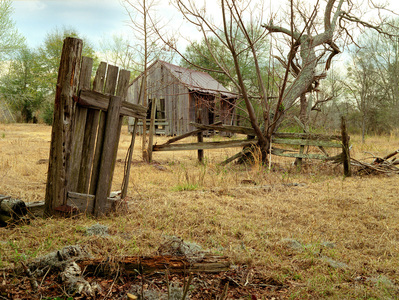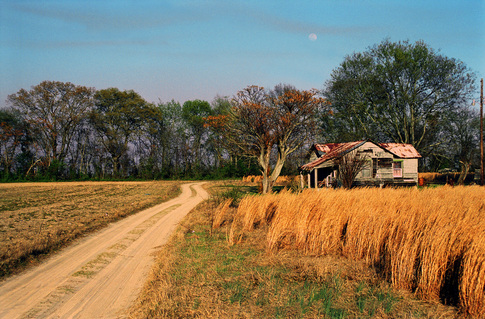
Chickens and Farmer - Hens dance a minuet around their food; a rooster supervises, and a farmer--in a noonday reverie--is seated in the background.

As I photographed this scene, I took an interest in the diagonals apparent in this pecan orchard in late autumn.

Old Store, Blackville - Though no longer standing, this Blackville landmark gained a certain glory during a long period of radiant decay.

Over a Barrel - I admit that I moved the barrel to bring out the lines inherent in this scene of rough sheds accompanied by a birdhouse.

This personalized shed with its captivating eccentricities is located just beyond the northern boundary of the city of Charleston. The neighborhood is a long-established one inhabited by the poor, near-poor, and working class. Near railroads, cemetaries, factories, and trucking routes, those living here have long built, buried, and transported to procure a livelihood.

A bulldozer sounds an alarm in strong yellow. This and a scarlet hopper are balanced by a cement block facade painted over in pastel tints. The old bathtub pressed into agricultural service is indispensable within the menagerie of details.

The exterior of this artist's residence displays a seemingly unplanned coordination of forms and colors, of natural elements and human interventions.

A long curvilinear root is in counterpoint with the assertive, perfectly round tire, which has no place to go--is without a destination--as it leans against a stolid tin shed.

I photographed this one-of-a-kind cottage on several occasions. No one one ever approached to inquire about my interest, give an account of the structure's background, or ask me to leave. It is likely that this was or still is simple house of praise for the meetings of an evangelical group. Just as likely, its current or former inhabitant wished to customize her/his surroundings. When the sunlight is at a proper angle, the radiance within is, without a doubt, impressive.

This farmhouse had been vacant for several years when the elderly owner and former resident said that I could photograph the varied sheds and other structures around it. When I last passed by, the house had vanished. I ought to have stopped and looked for the pear tree. Disconcerted, I simply drove on.

When I first saw this farmyard from the public road, I stepped on the property surreptitiously, afraid that if I asked permission to photograph, I could be denied. The sheds (of which only a few are visible here) and even the piles of debris offered tempting scenarios. Later I met the aged occupant of the adjacent house, a kindly man unperturbed unsurprised that a stranger wished to capture and preserve images of structures that might have already been decrepit when he was a youth and when the property was actively farmed.

The gate in the foreground and the fence midway back are all that is left of a pen for livestock. I learned that the fencing was destroyed by Hurrican Hugo. With the owner's go-ahead, I spent much time clipping vines and weeds to reveal the surviving remnants with their captivating bareness. Once the clearing out was complete, lighting was a problem, with a bank of trees just behind me, cutting out the morning sun. Backlighting was a drawback in the afternoons. I caught this image as clouds rolled in, subduing the bright spring sun and showering the rust-tinted roof. I had a few seconds to catch images before the rain drenched me and obscured the whole scene.

The barn struck me as archetypal, a perfect place to store hay and grain. I also wondered if the building had been assembled in an artist's studio, with much thought given to the degree of stain and discoloration that should intrude upon each piece of wood or metal. The roofs of the sheds in the background seemed designed to complement the slopes of the foreground image. It all appeared too fragile to stand for long, and the ensemble may have been held in place by invisible cables pinned into the dark hole high in the tree to the left.

Households that still rely on wood or coal as a source of heat--or for powering a cooking stove--are infrequent in rural South Carolina. The clothesline has been mostly replaced by the electric dryer. Similarly, the yard rarely persists as an extended living room or outdoor parlor. The current scene offers space for labor and relaxation, for people, pets, and barnyard fowl. In sum: self-sufficiency, whether by choice or necessity.

I had driven by this site on numerous occasions and had barely noticed the barn behind a stand of trees. Then most of the trees were cut down. The barn was revealed in its vacant splendor, and I realized why. Vide: the yellow bulldozer to the left, a seemingly small object that would clear a large area for some new purpose; the barn and other buildings would soon be razed. When I stopped one afternoon at the edge of the property to inspect, I saw that the most interesting views involved a mix of bright and dim lighting. Shortly thereafter, I arrived at dawn with camera in hand and a mild diffusion of morning light at my back. Some days later, only the small white structure remained.

This is an early spring scene that has the appearance of an autumn relic. Chinaberries have survived in abundance while the field of bronzed grass has the appearance of unharvested wheat. The temporal mix-up is also evident in the nearly full moon that did not wait for night to arrive. The sky too anticipates evening and bears a twilight pink along the horizon.

I was impressed by the erratic cadenza of lines and shapes in the handmade doors and latches of this shed. For some duration in the past, this must have been home for a small tractor or automobile. There is a visual fullness here along with the physical emptiness within.

